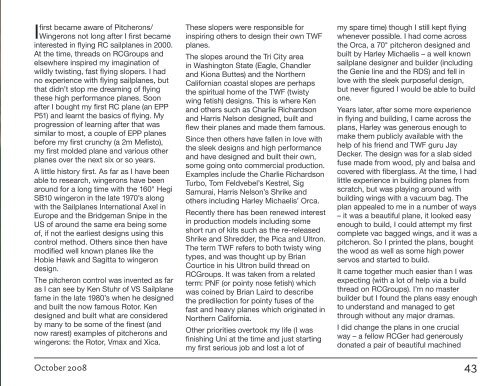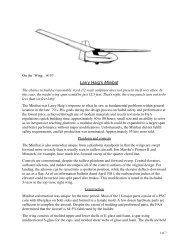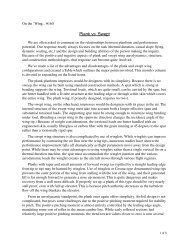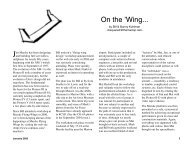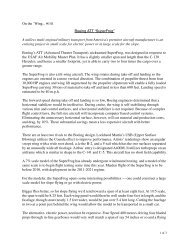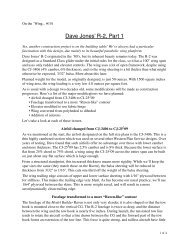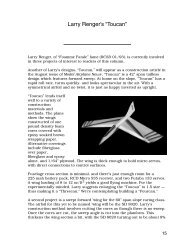Oct - Rcsoaring.com
Oct - Rcsoaring.com
Oct - Rcsoaring.com
- No tags were found...
Create successful ePaper yourself
Turn your PDF publications into a flip-book with our unique Google optimized e-Paper software.
first became aware of Pitcherons/I Wingerons not long after I first becameinterested in flying RC sailplanes in 2000.At the time, threads on RCGroups andelsewhere inspired my imagination ofwildly twisting, fast flying slopers. I hadno experience with flying sailplanes, butthat didn’t stop me dreaming of flyingthese high performance planes. Soonafter I bought my first RC plane (an EPPP51) and learnt the basics of flying. Myprogression of learning after that wassimilar to most, a couple of EPP planesbefore my first crunchy (a 2m Mefisto),my first molded plane and various otherplanes over the next six or so years.A little history first. As far as I have beenable to research, wingerons have beenaround for a long time with the 160" HegiSB10 wingeron in the late 1970’s alongwith the Sailplanes International Axel inEurope and the Bridgeman Snipe in theUS of around the same era being someof, if not the earliest designs using thiscontrol method. Others since then havemodified well known planes like theHobie Hawk and Sagitta to wingerondesign.The pitcheron control was invented as faras I can see by Ken Stuhr of VS Sailplanefame in the late 1980’s when he designedand built the now famous Rotor. Kendesigned and built what are consideredby many to be some of the finest (andnow rarest) examples of pitcherons andwingerons: the Rotor, Vmax and Xica.These slopers were responsible forinspiring others to design their own TWFplanes.The slopes around the Tri City areain Washington State (Eagle, Chandlerand Kiona Buttes) and the NorthernCalifornian coastal slopes are perhapsthe spiritual home of the TWF (twistywing fetish) designs. This is where Kenand others such as Charlie Richardsonand Harris Nelson designed, built andflew their planes and made them famous.Since then others have fallen in love withthe sleek designs and high performanceand have designed and built their own,some going onto <strong>com</strong>mercial production.Examples include the Charlie RichardsonTurbo, Tom Feldvebel’s Kestrel, SigSamurai, Harris Nelson’s Shrike andothers including Harley Michaelis’ Orca.Recently there has been renewed interestin production models including someshort run of kits such as the re-releasedShrike and Shredder, the Pica and Ultron.The term TWF refers to both twisty wingtypes, and was thought up by BrianCourtice in his Ultron build thread onRCGroups. It was taken from a relatedterm: PNF (or pointy nose fetish) whichwas coined by Brian Laird to describethe predilection for pointy fuses of thefast and heavy planes which originated inNorthern California.Other priorities overtook my life (I wasfinishing Uni at the time and just startingmy first serious job and lost a lot ofmy spare time) though I still kept flyingwhenever possible. I had <strong>com</strong>e acrossthe Orca, a 70" pitcheron designed andbuilt by Harley Michaelis – a well knownsailplane designer and builder (includingthe Genie line and the RDS) and fell inlove with the sleek purposeful design,but never figured I would be able to buildone.Years later, after some more experiencein flying and building, I came across theplans, Harley was generous enough tomake them publicly available with thehelp of his friend and TWF guru JayDecker. The design was for a slab sidedfuse made from wood, ply and balsa andcovered with fiberglass. At the time, I hadlittle experience in building planes fromscratch, but was playing around withbuilding wings with a vacuum bag. Theplan appealed to me in a number of ways– it was a beautiful plane, it looked easyenough to build, I could attempt my first<strong>com</strong>plete vac bagged wings, and it was apitcheron. So I printed the plans, boughtthe wood as well as some high powerservos and started to build.It came together much easier than I wasexpecting (with a lot of help via a buildthread on RCGroups). I’m no masterbuilder but I found the plans easy enoughto understand and managed to getthrough without any major dramas.I did change the plans in one crucialway – a fellow RCGer had generouslydonated a pair of beautiful machined<strong>Oct</strong>ober 2008 43


